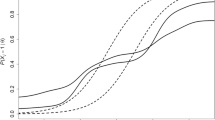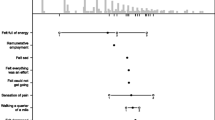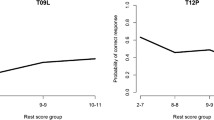Abstract
Self-reported health status is often measured using psychometric or utility indices that provide a score intended to summarize an individual's health. Measurements of health status can be subject to a ceiling effect. Frequently, researchers want to examine relationships between determinants of health and measures of health status. Regression methods that ignore the presence of a ceiling effect, or of censoring in the health status measurements can produce biased coefficient estimates. The Tobit regression model is a frequently used tool for modeling censored variables in econometrics research. The authors carried out a Monte-Carlo simulation study to contrast the performance of the Tobit model for censored data with that of ordinary least squares (OLS) regression. It was demonstrated that in the presence of a ceiling effect, if the conditional distribution of the measure of health status had uniform variance, then the coefficient estimates from the Tobit model have superior performance compared with estimates from OLS regression. However, if the conditional distribution had non-uniform variance, then the Tobit model performed at least as poorly as the OLS model.
Similar content being viewed by others
References
Stewart AL, Hays RD, Ware JE. Methods of constructing health measures. In: Stewart Al, Ware JE (eds), Measuring Function and Well-Being. The Medical Outcomes Study Approach, Durham and London: Duke University Press, 1992.
Froberg DG, Kane RL. Methodology for measuring health-state preferences ? I: Measurement strategies. J Clin Epidemiol 1989; 42: 345-354.
Feeny DH, Torrance GW, Furlong WJ. Health utilities index. In: Spilker B (ed), Quality of Life and Pharmaco-economics in Clinical Trials, 2nd edn. Philadelphia: Lippincott-Raven Press, 1996; 239–252.
Beckett LA, Brock BD, Lemke JH, et al. Analysis of change in self-reported physical function among older persons in four population studies. Am J Epidemiol 1996; 143: 766–778.
Gold M, Franks P, Erickson P. Assessing the health of nation: The predictive validity of a preference-based mea-sure and self-rated health. Medical Care 1996; 34: 163–177.
Bosch JL, van Wijck EEE, Baum PL, Donaldson MC, van den Dungen JJAM, Hunick MGM. The McMaster Health Utility Index (II) and the EuroQol-5D assessed in patients with peripheral arterial disease in the United States and the Netherlands. Medical Decision Making 1996; 16: 450 (abstract).
Snedecor GW, Cochran WG. Statistical Methods, 8th edn. Ames, Iowa: Iowa State University Press, 1989.
Saigal S, Feeny D, Furlong W, Rosenbaum P, Burrows E, Torrance G. Comparison of the health-related quality of life of extremely low birth weight children and a reference group of children at age eight years. J Pediatr 1994; 125: 418–425.
Revicki DA, Leidy NK, Brennan-Diemer F, Thomson C, Togias A. Development and preliminary validation of the multiattribute Rhinitis Symptom Utility Index. Qual Life Res 1998; 7: 693–702.
Raj SR, Simpson CS, Hopman WM, Singer MA. Health-related quality of life among final-year medical students. CMAJ 2000; 162: 509–510.
Badley EM, Howard M, Bombardier C. The Relative Im-pacts of Arthritis and Other Long-Term Health Problems in the Population: A Canadian Example. Toronto: Arthritis Community Research and Evaluation Unit, 1999.
Statistics Canada. NPHS Public Use Microdata Docu-mentation. Ottawa, Canada: Statistics Canada, 1995.
Torrance GW, Feeny DH, Furlong WJ, et al. Multiattrib-ute utility function for a comprehensive health status clas-sification system. Health Utilities Index Mar 2. Medical Care 1996; 34: 702–722.
The Ontario Health Survey 1990. User Guide Volume 1 Documentation. Ottawa, Ontario, Canada: Ontario Min-istry of Health, 1991.
Statistics Canada. General Social Survey (19); Public use Microdata File Documentation and User's Guide. Ottawa, Ontario: Ministry of Industry, Science and Technology, 1992.
Tobin J. Estimation of relationships for limited dependent variables. Econometrica 1958; 26: 24–36.
Pindyck RS, Rubinfeld DL. Econometric Models and Economic Forecasts, 4th edn. Boston: McGraw-Hill, 1998: 325.
SAS Institute Inc. SAS/STAT User's Guide, Version 6, 4th edn, Vol. 2. Cary, NC: SAS Institute Inc., 1989.
Statistical Sciences, Inc. S-Plus 5.1, Release 1. Seattle: StatSci, A division of MathSoft, Inc., 1999.
Greene WH. On the asymptotic bias of the ordinary least squares estimator of the Tobit model. Econometrica 1981; 49: 505–513.
Maddala GS. Limited-Dependent and Qualitative Vari-ables in Econometrics. New York: Cambridge University Press, 1983: 178–182.
Nelson FD. A test for misspecification in the censored normal model. Econometrica 1981; 49: 1317–1329.
Greene WH. Limdep Version 7.0 Users Manual Revised Edition. Plainview, NY: Econometric Software Inc., 1998.
Author information
Authors and Affiliations
Rights and permissions
About this article
Cite this article
Austin, P.C., Escobar, M. & Kopec, J.A. The use of the Tobit model for analyzing measures of health status. Qual Life Res 9, 901–910 (2000). https://doi.org/10.1023/A:1008938326604
Issue Date:
DOI: https://doi.org/10.1023/A:1008938326604




